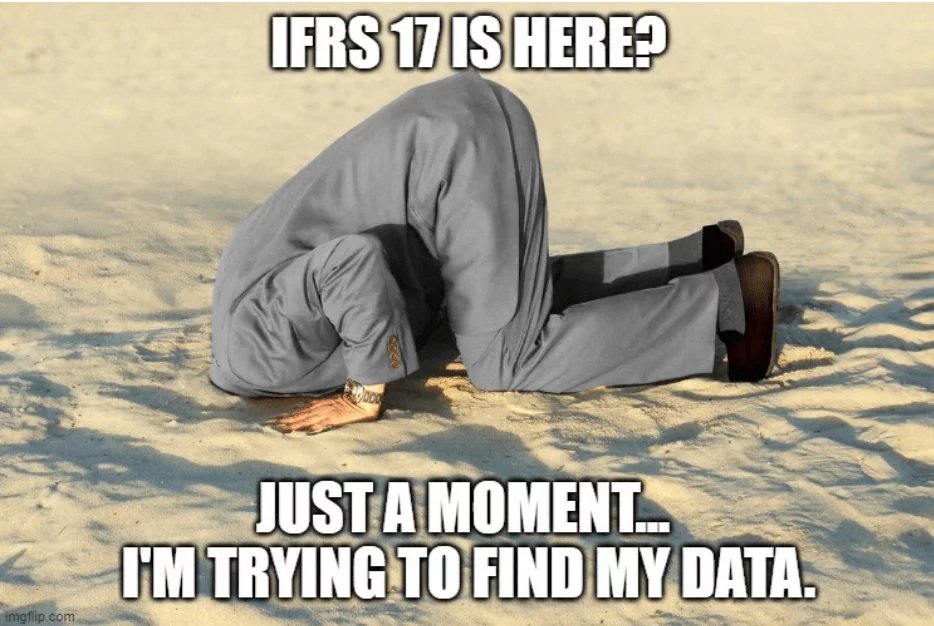When you hear about big regulatory changes like IFRS 17, you:
A. Jump for joy
B. Stare, paralyzed, at your computer like a deer in headlights
C. Hide your head in the sand

If you’re a well-rounded finance professional, your answer might in fact be:
D. All of the above.
IFRS 17 brings potential for more accurate reporting and valuation of your insurance company’s contracts – both by internal analysts and external investors.
But the way to get there can be full of frustrations and overwhelm as you try and whip your data management and reporting systems into shape.
Let’s take a look at the IFRS data requirements, and what preparations can smooth the way to full compliance.
IFRS 17 Insurance Contracts in a Nutshell
IFRS 17 (International Financial Reporting Standard 17) is an accounting standard that intends to make financial reporting on insurance contracts more transparent and consistent across the insurance industry.
Consistency is important when you’re a financial analyst or investor. Comparing apples to oranges can drive you bananas.
But apples-to-apples comparisons have, historically, been tricky with insurance contracts. For any given contract, you have to traverse a sea of questions, like: Is the valuation of the contract according to market value or present value based on cash flow? Which cash flows and liabilities are included? When do you value those cash flows? How does discounting factor into the cash flow value? How does risk change the valuation?
IFRS 17 will go into effect on January 1, 2023 (if they don’t push it off for the third time, that is), requiring global insurance companies to hold to a unified standard when issuing financial statements.
The ability to make apples-to-apples comparisons between insurance contracts and insurance companies will reduce misvaluation and enable wiser decision-making both within insurance companies and by external parties.
Need a Refresher on Data Lineage and Its Use Cases?
Check out our eBook, "The Essential Guide to Data Lineage in 2021"
Download the eBook
It’s All in the Data
Increasing the accuracy of valuation sounds great. It hinges, however, on harnessing, interpreting, and using data in the specific ways set out by IFRS 17.
Reporting on each insurance contract will be based on very granular, data-informed building blocks. Most contracts will require you to calculate the contractual service margin (CSM) using all the risk adjusted, discounted, future cash flows of the contract. This includes premiums, claims, acquisition costs, related expenses, and possibly investment components.
You may be wondering how easy will it be for your insurance company:
- to calculate the CSM of its contracts?
- to transparently show the exact data path by which you calculated it?
- to answer auditors’ questions about the calculation process?
If you shouted, “Easy as pie!”, we’re happy for you.
If you mumbled something else, went back to your deer-in-headlights stance, or knew flat-out that these are questions are currently unanswerable for you, let’s see what can help you reach that easy-as-pie euphoria.

Automated Data Lineage: Confidence and Control
During data’s journey through your systems, it interacts with other pieces of information, is transformed, interpreted, and utilized in various reports. Data lineage is the ability to trace any data set in a report back through its journey and to understand exactly what happened to it, when, and why.
The level of transparency and accountability mandated by IFRS 17 compliance requires the ability to perform data lineage quickly and without errors.
Before automated tools, “quick, error-free data lineage” was an oxymoron. Manually tracing data lineage took days or weeks… and that was before you could then use the data lineage information to draw conclusions or fix mistakes.
Trying to comply with IFRS 17 using manual data management processes would require your BI group to resemble a sweatshop (which would violate regulations that long precede any IFRS).
Automated data lineage eliminates the need for sentencing your BI team to hard labor. Automation speeds up the process in order to track down what happened to your data and where it happened, in minutes, not days or weeks.
Automated data lineage allows insurance companies to have a full grasp on their IFRS 17 data models by transparently laying out the data’s path. This will explain any discrepancies and allows the BI team to answer questions about the data in a matter of minutes or hours. Since the data landscape is constantly evolving, BI teams can remain confident in their numbers and know that they are fully compliant with IFRS 17.
Can anyone say, “easy as pie”?

Investing in the Future
Today IFRS 17 may be the cause for head-hiding. There’s no doubt that compliance puts a strain on insurance companies (one of the reasons that the IASB keeps pushing off the effective date).
But the challenge of IFRS 17 data management is an opportunity.
The impetus to invest in automated data lineage and the latest metadata management tools and technology is a blessing in disguise for forward-thinking insurance companies that want to maximize their potential for ever-greater profitability.
Now that’s a good insurance policy.






